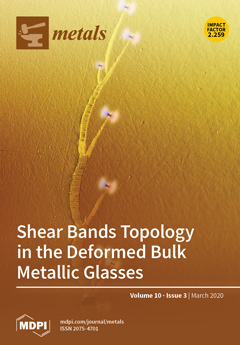Arsenopyrite (FeAsS) is often associated with gold, but pre-treatment is necessary prior to gold leaching, mainly due to the gold encapsulation in the matrix of FeAsS. Bio-oxidation is attractive and promising, largely due to its simplicity, low cost and environmental friendliness. A critical
[...] Read more.
Arsenopyrite (FeAsS) is often associated with gold, but pre-treatment is necessary prior to gold leaching, mainly due to the gold encapsulation in the matrix of FeAsS. Bio-oxidation is attractive and promising, largely due to its simplicity, low cost and environmental friendliness. A critical problem that still impedes the large-scale applications of this green technology is its slow leaching kinetics. Some metal ions such as Ag
+ have previously been found to expedite the bioleaching process. In this paper, the role of Ag
+ in the arsenopyrite bioleaching by
Acidithiobacillus ferrooxidans was investigated in detail by bioleaching experiments and a series of analyses including thermodynamics, X-ray diffraction (XRD), scanning electron microscopy (SEM) and X-ray photoelectron spectroscopy (XPS). Experimental results suggested that addition of 5 mg/L Ag
+ to the leaching system could significantly improve the final As leaching efficiency from 30.4% to 47.8% and shorten the bioleaching period from 19 days to 15 days. Thermodynamic analysis indicates that Ag
+ destabilises As
2S
2, As
2S
3 and S
0 via forming Ag
2S, which is confirmed by the XRD analysis on the phase transformation during bioleaching. SEM and XPS analyses further showed that Ag
+ removed the passivating film consisting mainly of As
2S
2, As
2S
3 and S
0 because Ag
2S formed on the arsenopyrite surface from the start bioleaching of 36 h. In the presence of Fe
3+, Ag
2S could easily be dissolved to Ag
+ again, likely leading to the establishment of the Ag
+/Ag
2S cycle. The bacteria utilised the two synergistic cycles of Fe
3+/Fe
2+ and Ag
+/Ag
2S to catalyse the bioleaching of arsenopyrite.
Full article





